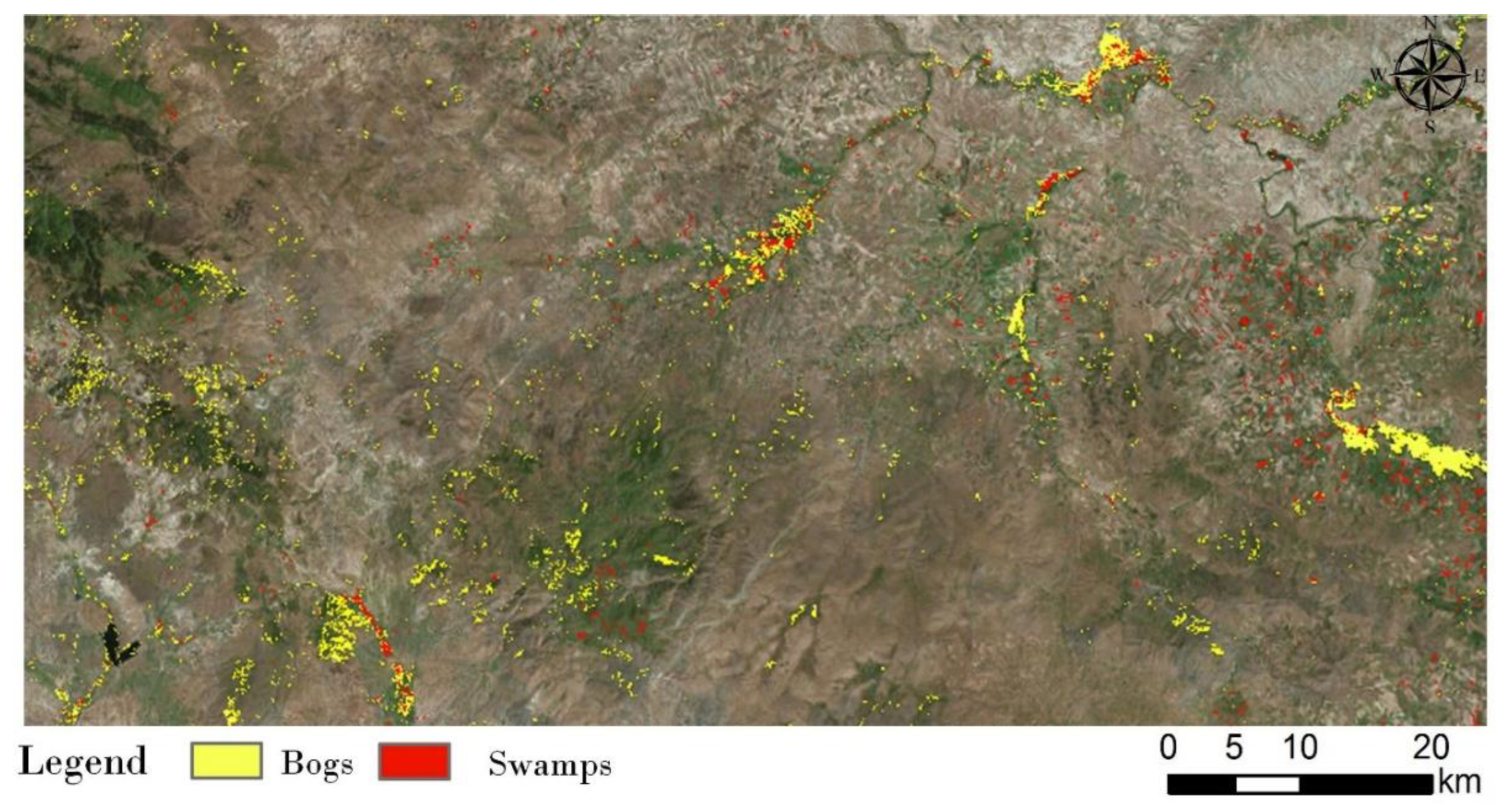Evaluating Sentinel-2 Red-Edge Bands for Wetland Classification †
Abstract
:1. Introduction
2. Data and Methodology
3. Results
4. Discussion
5. Conclusions
Author Contributions
Acknowledgments
Conflicts of Interest
Abbreviations
| SVM | support vector machine |
| UAV | unmanned aerial vehicle |
| OBIA | object-based image analyses |
| ESA | European Space Agency |
| SPOT | Satellite Pour l'Observation de la Terre |
References
- Sghair, A.; Goma, F. Remote sensing and GIS for wetland vegetation study. Diss. University of Glasgow. 2013. [Google Scholar]
- Ji, W. Wetland and Water Resource Modeling and Assessment: A Watershed Perspective; CRC Press: Boca Raton, FL, USA, 2007. [Google Scholar]
- Russi, D.; ten Brink, P.; Farmer, A.; Badura, T.; Coates, D.; Förster, J.; Kumar, R.; Davidson, N. The Economics of Ecosystems and Biodiversity for Water and Wetlands; IEEP: London and Brussels, 2013; p. 78. [Google Scholar]
- Mitsch, W.J.; Hernandez, M.E. Landscape and climate change threats to wetlands of North and Central America. Aquat. Sci. 2013, 75, 133–149. [Google Scholar] [CrossRef]
- Dronova, I. Object-Based Image Analysis in Wetland Research: A Review. Remote Sens. 2015, 7, 6380–6413. [Google Scholar] [CrossRef]
- Delegido, J.; Verrelst, J.; Alonso, L.; Moreno, J. Evaluation of Sentinel-2 Red-Edge Bands for Empirical Estimation of Green LAI and Chlorophyll Content. Sensors 2011, 11, 7063–7081. [Google Scholar] [CrossRef]
- Abdikan, S.; Sekertekin, A.; Ustunern, M.; Sanli, F.B.; Nasirzadehdizaji, R. Backscatter analysis using multi-temporal sentinel-1 sar data for crop growth of maize in konya basin, Turkey. ISPRS Int. Arch. Photogramm. Remote Sens. Spat. Inf. Sci. 2018, 9–13. [Google Scholar] [CrossRef]
- Üstüner, M.; Şanlı, F.B.; Bilgin, G.; Abdikan, S. Land use and cover classification of Sentinel-IA SAR imagery: A case study of Istanbul. In Proceedings of the 2017 25th Signal Processing and Communications Applications Conference (SIU), Antalya, Turkey, 15–18 May 2017; pp. 1–4. [Google Scholar]
- Civco, D.; Hurd, J.; Prisloe, S.; Gilmore, M. Characterization of coastal wetland systems using multiple remote sensing data types and analytical techniques. In Proceedings of the 2006 IEEE International Symposium on Geoscience and Remote Sensing, Denver, CO, USA, 31 July–4 August 2006; pp. 3442–3446. [Google Scholar]
- Malenovský, Z.; Rott, H.; Cihlar, J.; Schaepman, M.E.; García-Santos, G.; Fernandes, R.; Berger, M. Sentinels for science: Potential of Sentinel-1, -2, and -3 missions for scientific observations of ocean, cryosphere, and land. Remote Sens. Environ. 2012, 120, 91–101. [Google Scholar] [CrossRef]
- Drusch, M.; Del Bello, U.; Carlier, S.; Colin, O.; Fernandez, V.; Gascón, F.; Hoersch, B.; Isola, C.; Laberinti, P.; Martimort, P.; et al. Sentinel-2: ESA’s Optical High-Resolution Mission for GMES Operational Services. Remote Sens. Environ. 2012, 120, 25–36. [Google Scholar] [CrossRef]
- D’Odorico, P.; Damm, A.; Gonsamo, A.; Schaepman, M.E. Experimental Evaluation of Sentinel-2 Spectral Response Functions for NDVI Time-Series Continuity. IEEE Trans. Geosci. Remote Sens. 2013, 51, 1336–1348. [Google Scholar] [CrossRef]
- Selva, M.; Aiazzi, B.; Butera, F.; Chiarantini, L.; Baronti, S. Hyper-Sharpening: A First Approach on SIM-GA Data. IEEE J. Sel. Top. Appl. Earth Obs. Remote Sens. 2015, 8, 3008–3024. [Google Scholar] [CrossRef]
- Gašparović, M. and Jogun, T. The effect of fusing Sentinel-2 bands on land-cover classification. Int. J. Remote Sens. 2018, 39, 822–841. [Google Scholar] [CrossRef]
- Kaplan, G. Sentinel-2 Pan Sharpening—Comparative Analysis. Proceedings 2018, 2, 345. [Google Scholar]
- Kaplan, G.; Avdan, U. Monthly Analysis of Wetlands Dynamics Using Remote Sensing Data. ISPRS Int. J. Geo-Inf. 2018, 7, 411. [Google Scholar] [CrossRef]
- Özelmas, Ü.; Karakaya, M. The ornithofauna of Eskişehir/Türkiye. Biol. Divers. Conserv. 2008, 4, 19–28. [Google Scholar]
- Schuster, C.; Forster, M.; Kleinschmit, B. Testing the red edge channel for improving land-use classifications based on high-resolution multi-spectral satellite data. Int. J. Remote Sens. 2012, 33, 5583–5599. [Google Scholar] [CrossRef]
- Chatziantoniou, A.; Petropoulos, G.P.; Psomiadis, E. Co-Orbital Sentinel 1 and 2 for LULC Mapping with Emphasis on Wetlands in a Mediterranean Setting Based on Machine Learning. Remote. Sens. 2017, 9, 1259. [Google Scholar] [CrossRef]



© 2019 by the authors. Licensee MDPI, Basel, Switzerland. This article is an open access article distributed under the terms and conditions of the Creative Commons Attribution (CC BY) license (https://creativecommons.org/licenses/by/4.0/).
Share and Cite
KAPLAN, G.; AVDAN, U. Evaluating Sentinel-2 Red-Edge Bands for Wetland Classification. Proceedings 2019, 18, 12. https://doi.org/10.3390/ECRS-3-06184
KAPLAN G, AVDAN U. Evaluating Sentinel-2 Red-Edge Bands for Wetland Classification. Proceedings. 2019; 18(1):12. https://doi.org/10.3390/ECRS-3-06184
Chicago/Turabian StyleKAPLAN, Gordana, and Ugur AVDAN. 2019. "Evaluating Sentinel-2 Red-Edge Bands for Wetland Classification" Proceedings 18, no. 1: 12. https://doi.org/10.3390/ECRS-3-06184
APA StyleKAPLAN, G., & AVDAN, U. (2019). Evaluating Sentinel-2 Red-Edge Bands for Wetland Classification. Proceedings, 18(1), 12. https://doi.org/10.3390/ECRS-3-06184





